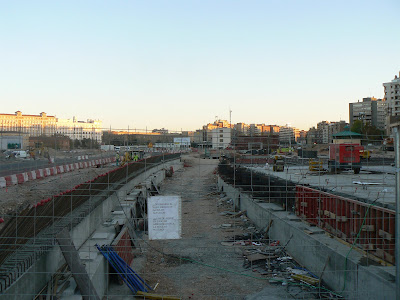An Antiquated Rail Trip
I have saved five days of my Eurail Pass for trips within Spain. The Eurail idea has proven to be an antiquated waste of money. Only once on the trip thus far has the pass been a savings vs. buying the ticket outright. Now, within Spain the tickets are so inexpensive that I am in essence paying twice the normal ticket price by using the pass… bummer. Just ten years ago the Eurail pass was as essential as a passport.
Security is a serious issue in the train stations of Spain since their “9-11” in 2004, when al-Qaeda backed Moroccans blew up commuter trains, killing 191 people and injuring 1,700 others.
The regional trains in Spain look like a fall back to the 1950’s “Air Stream” design. Antiquated would be a generous description.
Everything inside is functional, but constructed of heavy gage steel, hard foam, and heavy fibers that capture the essence of seeming eons of travel.
If the “rain in Spain falls mostly on the plain” then this must not be the plain. The surrounding landscape outside of Bilbao is arid and becoming increasingly so the closer we come to Zaragoza.
There are miles of sandy earth vineyards that must be sustained by an imperceptible irrigation system, …
… followed by dry dusty acres with hills in the distance.
We stop in the tiny station of Castejon de Ebro to change engines and add more of the stainless steel “bread boxes” to the growing line of rail cars.
In order to breathe, the Spanish people seem to need to do it through a cotton filter. They appear to smoke even more than the Turks. So the passengers take this break to refuel on nicotine. Thank goodness the cars are now non-smoking, but the thick layers still linger, sticking to the walls and upholstery.
The good news of the day was that we weren’t traveling in this train. There’s always upside. :-)
The city of Zaragoza has a brand new train station, as the city prepares for the 2008 Exposition. Basically the EU hi-lights a city, much like a World’s Fair and people from all over Europe travel to see the renovations and exhibits.
The rest of the town is an “urban center” typical of so many European cities, with medium-rise apartments crowding the streets.
This was marked as the “plaza antiguo” on the city map. Uh… does look there is much left of anything old here.
As the sun sets on the church domes, that is my signal to head back to the hostel.
One last image caught my eye. A building was obviously torn down, but what remains of the original is a room-by-room depiction of wallpaper. This was very interesting and fun to guess which room was decorated with which paper.
November 8th, 2007 - To Zaragoza
Subscribe to:
Post Comments (Atom)















No comments:
Post a Comment